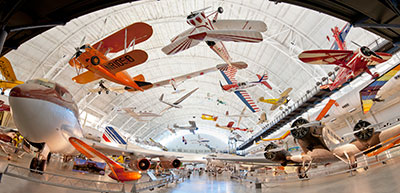National Air and Space Museum Expands Its Steven F. Udvar-Hazy CenterThe Smithsonian's National Air and Space Museum has announced the expansion of its Steven F. Udvar-Hazy Center in Chantilly, Virginia. This will be the first major construction and physical change to the center's public areas since its opening in 2003.

Additional display space will be added to the north end of the Boeing Aviation Hangar, increasing its size by 20%. The additional 44,000 square feet of space will allow the museum to bring artifacts out of storage and display new acquisitions.
Construction is anticipated to be complete at the end of 2028, at which point the museum will begin to move artifacts into this new space. Like the rest of the center, the expansion will be privately funded.
"We are excited for this expansion of our world-class facility in Virginia," said Chris Browne, the John and Adrienne Mars Director of the museum. "Adding on to the Udvar-Hazy Center will allow us to offer even more to the public and will give us a chance to make major changes to the arrangement of artifacts in the entire center, enhancing the experience for our visitors."
The expansion of the Udvar-Hazy Center creates an opportunity to rearrange the current configuration of aircraft in the Aviation Hangar; this will start before construction is complete and continue for several years after. The increased square footage of the building will not only display new artifacts once the space is constructed, but it will also be part of a larger rearrangement of the current artifacts in the hangar.
This will allow display of new acquisitions and artifacts from storage in the corresponding subject areas. For example, the Martin B-26 Marauder "Flak-Bait" will be installed in the World War II section, which is located in the center of the hangar.
While plans are still being finalized, some of the artifacts from the museum's collection that are planned for display after the expansion are the Boeing B-17 Flying Fortress "Shoo Shoo Shoo Baby" and the previously mentioned "Flak-Bait," both of which have never been displayed at the center fully assembled. Others will include the restored Sikorsky JRS-1, a Pearl Harbor survivor; the De Havilland DH-98B Mosquito; and the Franklin "Texaco Eaglet." The museum expects to receive new acquisitions that will also go on display prior to construction completion. The Udvar-Hazy Center will remain open during construction.
The U.S. Congress authorized the Smithsonian to build the Air and Space Museum extension at Washington Dulles International Airport in 1992. Udvar-Hazy was opened in 2003, in time to celebrate the centennial of the Wright brothers' first flight. In 2011, the museum finished construction on its world-class collections spaces that house archives as well as conservation and restoration work—a portion of which is on public view. The center is one of the top-20 most-visited museums in North America, welcoming more than 1 million visitors per year.
The museum is currently undergoing a $60 million campaign to secure funding for the addition. Support for the expansion thus far has been provided by Steven and Christine Udvar-Hazy, Charles and Lisa Simonyi, Sarah and Ross Perot Jr., the Thomas W. Haas Foundation and the Air Lease Corp.












